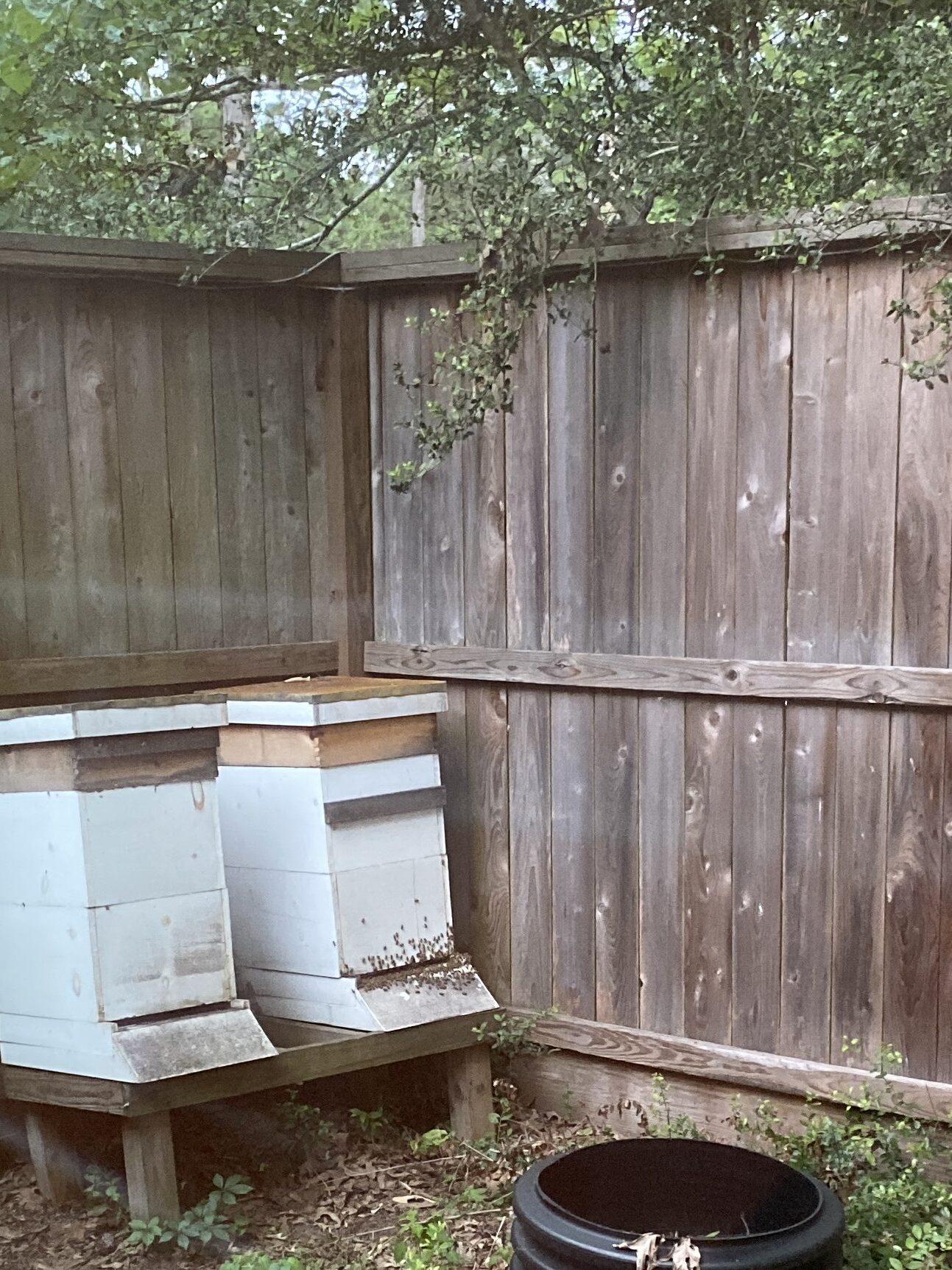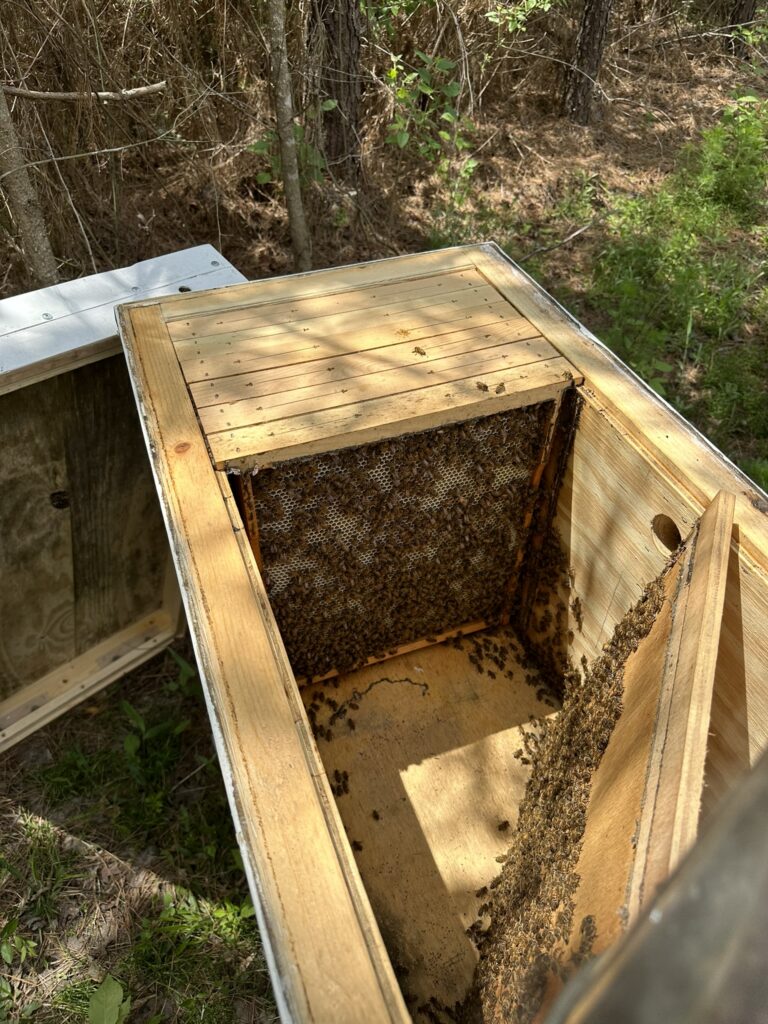When considering beekeeping, one of the first things to consider is what kind of hive you will use. For most people, the only hive style known is what is known as a langstroth hive, and for good reason. It is the style used predominantly in the US. This is a style which uses a stack of boxes, with the quantity (and often the height) which change during the year. This is the least expensive type, and really provides the most availability of parts. Below, you will see a picture of two langstroth hives.

You can see in the above picture that there is a stand, a cover, and 3 boxes between them. The lower box(es) are there for the bees to propagate new bees. These lower boxes are “brood boxes.” The unpainted short box on the top of both of these is a “honey Super,” which is specifically added to allow the bees to fill with honey. This box is typically removed and the honey is harvested by the beekeeper. Over winter, you will typically see either one or two brood boxes on hives. These boxes need to contain enough honey for the colony to have food for the winter. In Texas, this is a bit less of a concern than some regions, but it is still something that needs to be considered.
Why would you want to use another style, you may ask. There are various reasons, but for me, considering that I am in South Texas, the biggest reason is to not have the stacked boxes. When these (deep) boxes are full of bees and / or honey, they can weigh 80+ pounds. With this weight, it is a workout to move these boxes for inspections and pulling honey frames out. In addition, to inspect the hive, there are times that all of the hive frames need to be inspected. To do this, each box must be removed, which agitates the colony, and there is always risk of dropping a box. In addition, it is thought that by inspecting these hives, the colony’s progress in building up is set back. Between the beekeeper’s back and the colony’s mood and progress, I believe that we should be using a hive style which is not stacked. With a horizontal style hive, frames are added or removed from the end to allow for a larger or smaller colony. Once again, with my hives being located in Texas, I am not as concerned about winters. For those in cold climates, a tall hive can be beneficial since the bees stay in a cluster, working their way up through the elevation and honey stores during winter (staying away from the walls of the hive). This can be accounted for as well, as will be discussed below.
The bees need to maintain a reasonable temperature inside the hive, or at least in the cluster of bees. During winter, this means that they cluster in the middle of the hive, as briefly discussed above. In our climate, there is also a concern of summer temperatures since the boxes can get too hot. The problem with standard langstroth hives is that they are made from 3/4″ thick wood, which will allow the sun to heat the hive during the summer and chill it during the winter. Because of this, some hive styles will be constructed of “2 by” material, which is 1-1/2″ thick or they will actually be insulated with wool or some other insulating material. These styles provide an environment which the bees can more easily control the internal temperature.
From here, it is a decision of what frame size and shape we want to use. Once again, langstroth can be used in a horizonal hive configuration. This provides the best availability of parts, other than the hive body itself since the internal parts are the same, generally, as the standard langstroth hive. The downside to this style is that the frames, even the deep version, may not be tall enough for winters, which is why many people use stacked deep hive bodies for over-wintering their bees (as I used to as well). To allow bees additional height, some will use a double deep horizontal hive, but now, we are back to having more intrusive inspections. There is an alternate hive style which is used a lot in Europe, called Leyens Hives. This is a horizontal hive, but the frame size is much deeper than langstroth frames, so this provides a better over-wintering condition for the bees. Here is a picture of a Layens (wool insulated) Hive:

With the single depth of a horizontal hive and additional depth, my preference on hive type is the Layens hive, specifically with some form of insulation or thick walls.
Alternatively, there are a couple other hive styles which could be considered. First, a version of a langstroth is really a device which allows for less effort in honey harvesting. This device is called the Flow Hive. When it is time to harvest, it can be done without removing the box from the hive, and the honey flows right into your jars. It is a quite intriguing device, but I have not used it, so cannot comment much. Opponents to it have concerns that inspection is not as easy, and for me, it is a stacked hive, so unless a horizontal langstroth is modified to fit this, then it would be a fully stacked design. There is another style which is always a horizontal design is a “Top Bar” hive. This is a very simple design, which the bees build their comb on a top bar, and not in a 4 sided frame. This style is not nearly as tall as the Leyens Hive, and it also has limited methods for harvesting the honey since the comb is not in a frame.
If you would like to learn more these hive types, here are some links:
Leyens: https://horizontalhive.com/
Top Bar: https://www.bee-mindful.com/
Flow Hive: https://www.honeyflow.com/